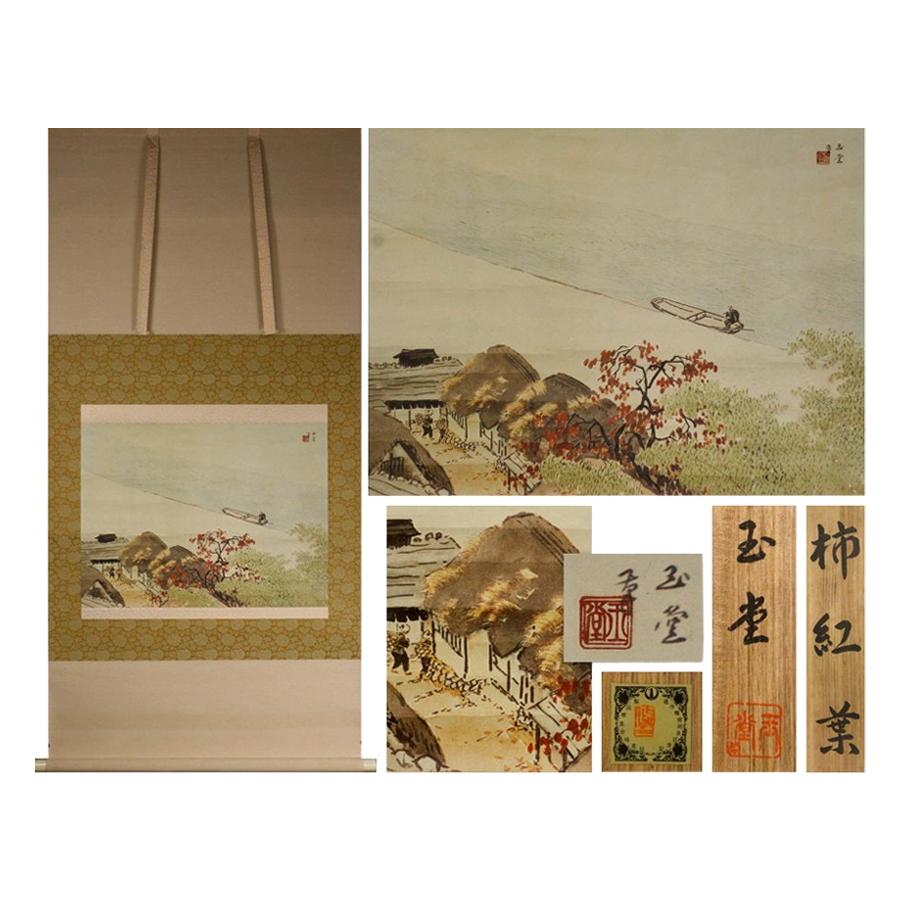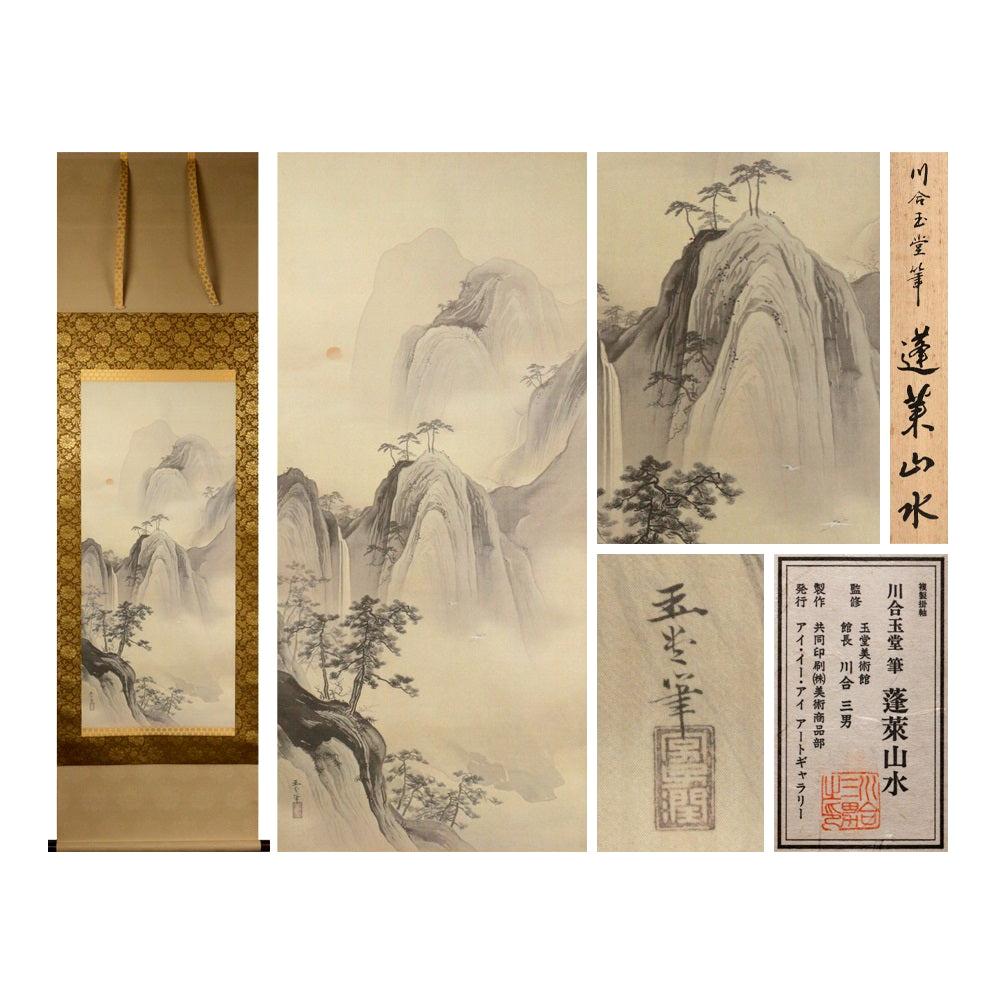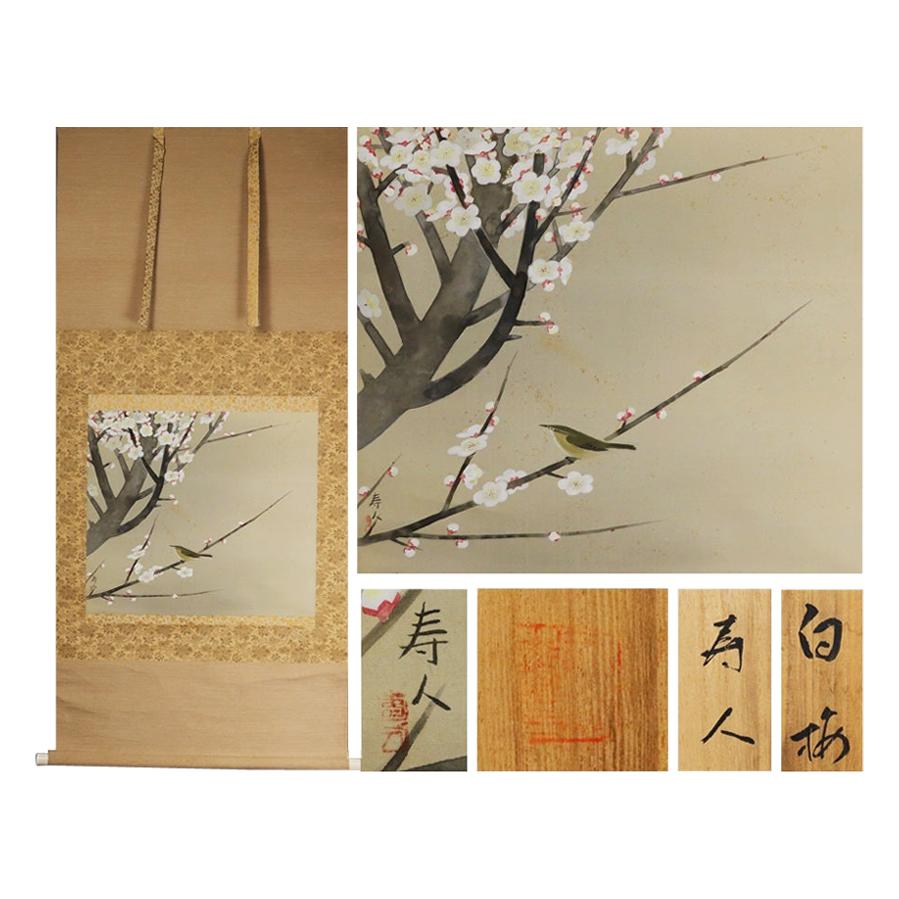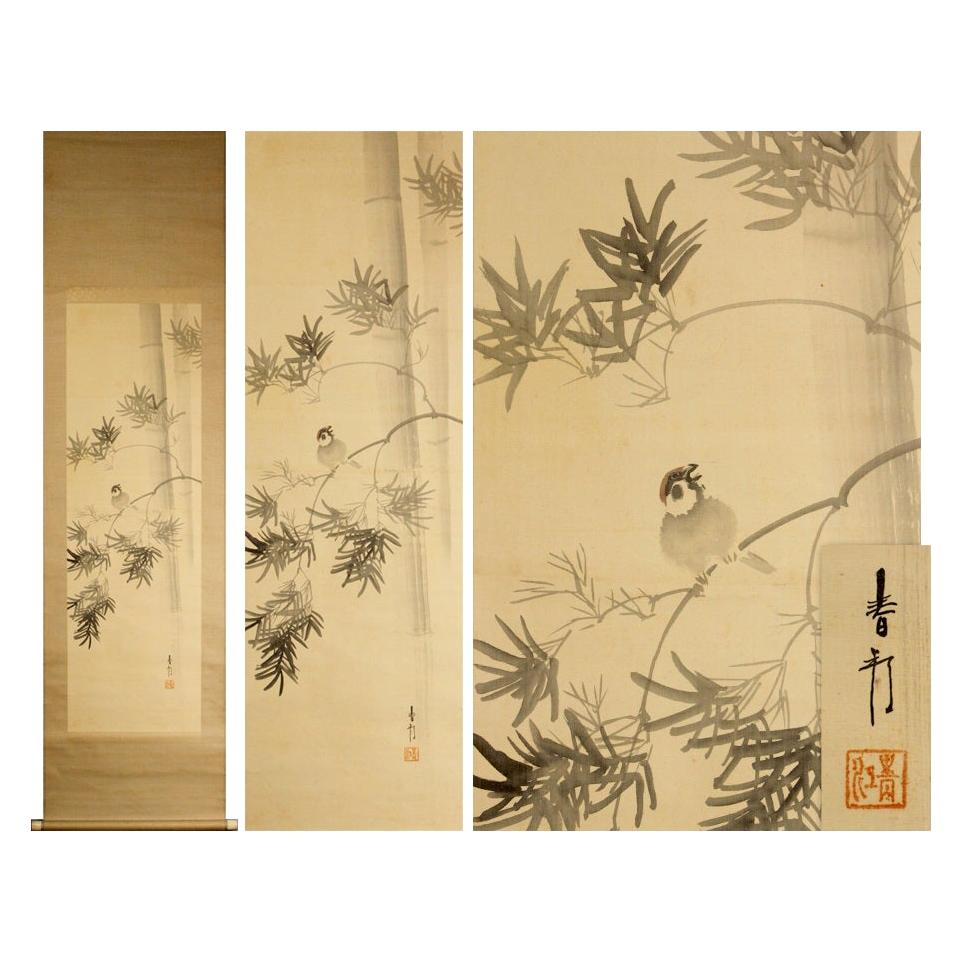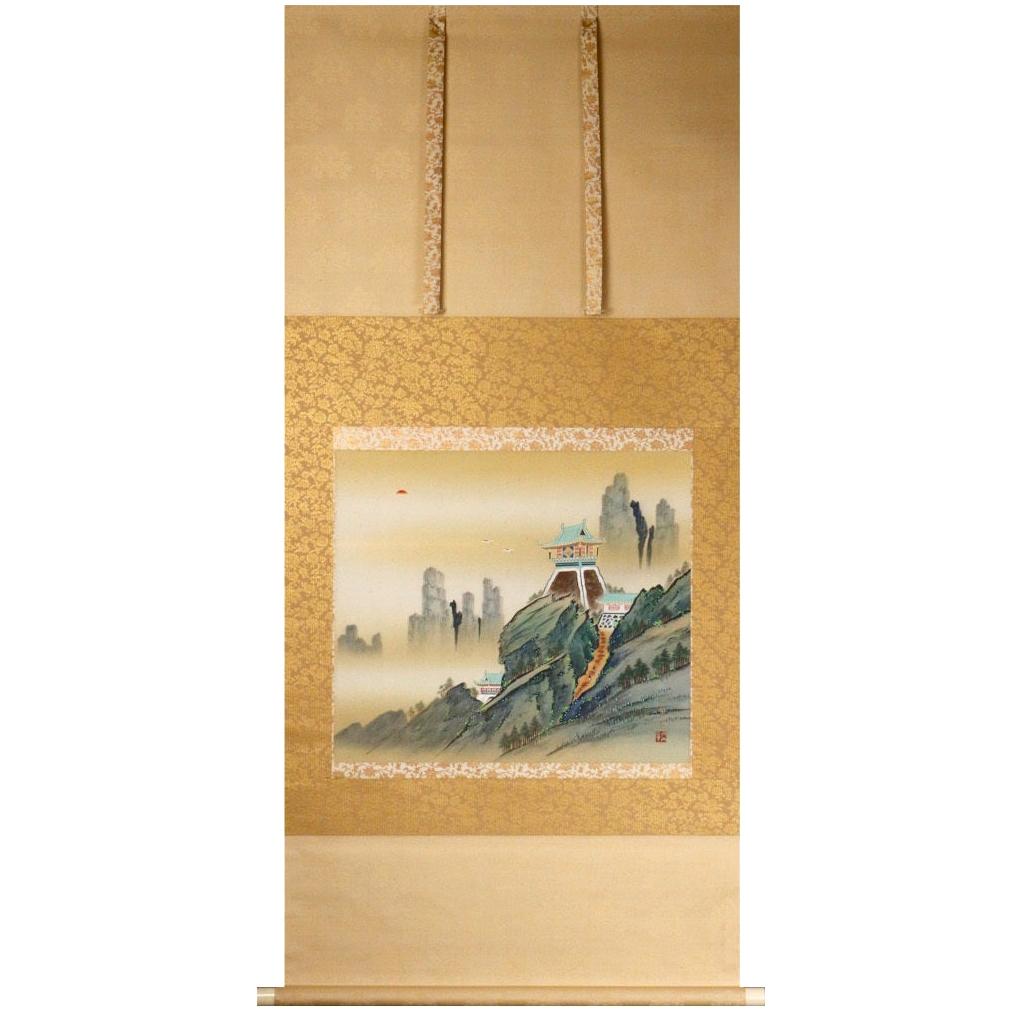Items Similar to Artists Norikuni Kawamura, Showa Period Scroll Japan 20c Artist Nihonga
Want more images or videos?
Request additional images or videos from the seller
1 of 5
Artists Norikuni Kawamura, Showa Period Scroll Japan 20c Artist Nihonga
About the Item
As you can see, it is a double box and a box with "Shokakuzu" written by Norikuni Kawamura.
The
"Shokaku-zu", which is composed of graceful textures, spreads its wings and flies, is a truly attractive work.
«Norikuni Kawamura»
Born in Fukuoka Prefecture in 1918.
Graduated from the former Kyoto Arts and Crafts School.
24 times of Nitten. Bunten 3 times. Seki Exhibition Award 3 times. Art Academy Award 3 times.
Purchased the Ueno Royal Museum. Lives in Kamigyo-ku, Kyoto.
¦ Silk book / handwriting.
¦
There is me etc. in the state era.
¦ Shaft dimensions / approx. 135.5 cm x approx. 66.0 cm.
¦ Paper dimensions / approx. 43.0 cm x approx. 50.5 cm.
¦ Signs / There are inscriptions and seals as you can see.
¦ Box / Co-box (It is a box for thick sushi, but the thick sushi is gone.) · Double box.
- Dimensions:Height: 53.15 in (135 cm)Width: 25.99 in (66 cm)Depth: 0.04 in (1 mm)
- Style:Showa (Of the Period)
- Materials and Techniques:
- Place of Origin:
- Period:
- Date of Manufacture:20th Century
- Condition:Wear consistent with age and use. ■ Silk book / handwriting. ■ There is me etc. in the state era. ■ Shaft dimensions / approx. 135.5 cm x approx. 66.0 cm. ■ Paper dimensions / approx. 43.0 cm x approx. 50.5 cm. ■ Signs / There are inscriptions and seals as you can see. ■ Box / Co-b.
- Seller Location:Amsterdam, NL
- Reference Number:
About the Seller
5.0
Gold Seller
These expertly vetted sellers are highly rated and consistently exceed customer expectations.
Established in 2015
1stDibs seller since 2019
158 sales on 1stDibs
Typical response time: 9 hours
- ShippingRetrieving quote...Ships From: Amsterdam, Netherlands
- Return PolicyA return for this item may be initiated within 14 days of delivery.
More From This SellerView All
- Artists Kawai Gyokudō Showa Period Scroll Japan 20c Artist NihongaLocated in Amsterdam, Noord HollandKawai Gyokudo (?? ??, November 24, 1873-June 30, 1957) was the pseudonym of a Japanese painter in the Nihongo school, active from Meiji through Showa period Japan. His real name was Kawai Yoshisaburo. Contents Biography Gyokudo was born in what is now Ichinomiya city, Aichi Prefecture, as the eldest son of a paper, ink and brush merchant. He went to Kyoto in 1887 to study under Kono Bairei of the Maruyama-Shijo school of painting. In 1896, he moved to Tokyo and he became the student of Hashimoto Gaho, of the Kano school. He also studied Western-style painting and developed a highly personal style, especially in the field of landscape painting. Gyokudo is noted for his polychrome and occasionally monochrome works depicting the mountains and rivers of Japan in the four seasons, with humans and animals shown as part of the natural landscape. Among his representative works are Futsuka zuki (“The New Moon”), Yuku haru (“The Departing Spring”), Mine-no-yu (“Evening at the Mountain Top”), and Bosetsu (“Snow in the Evening”). In 1898, Gyokudo joined with Okakura Tenshin and Yokoyama Taikan...Category
20th Century Japanese Taisho Paintings and Screens
MaterialsSilk
- Artists Suiho Yano Showa Period Scroll Japan 20c Artist NihongaLocated in Amsterdam, Noord HollandAs you can see, it is a work of "Basho / Sparrow" drawn by Midori Yano. Under Basho, this work skillfully depicts the appearance of sparrows forming a flock and singing food. «Su...Category
20th Century Japanese Taisho Paintings and Screens
MaterialsSilk
- Artists Kawai Gyokudō Showa Period Scroll Japan 20c Artist NihongaLocated in Amsterdam, Noord HollandKawai Gyokudo (?? ??, November 24, 1873-June 30, 1957) was the pseudonym of a Japanese painter in the Nihongo school, active from Meiji through Showa period Japan. His real name was Kawai Yoshisaburo. Contents Biography Gyokudo was born in what is now Ichinomiya city, Aichi Prefecture, as the eldest son of a paper, ink and brush merchant. He went to Kyoto in 1887 to study under Kono Bairei of the Maruyama-Shijo school of painting. In 1896, he moved to Tokyo and he became the student of Hashimoto Gaho, of the Kano school. He also studied Western-style painting and developed a highly personal style, especially in the field of landscape painting. Gyokudo is noted for his polychrome and occasionally monochrome works depicting the mountains and rivers of Japan in the four seasons, with humans and animals shown as part of the natural landscape. Among his representative works are Futsuka zuki (“The New Moon”), Yuku haru (“The Departing Spring”), Mine-no-yu (“Evening at the Mountain Top”), and Bosetsu (“Snow in the Evening”). In 1898, Gyokudo joined with Okakura Tenshin and Yokoyama Taikan...Category
20th Century Japanese Taisho Paintings and Screens
MaterialsSilk
- Artists Miyao Jujin, Showa Period Bird and Plum Scroll Japan 20c Artist NihongaLocated in Amsterdam, Noord HollandAs you can see, Hisato Miyao, Okayama Prefecture, wrote "Shiraume" plum and warbler, and comes with a box. It is a plum and warbler figure expressed in a truly wonderful color, and...Category
20th Century Japanese Showa Paintings and Screens
MaterialsSilk
- Artists Miyao Jujin, Showa Period Bird and Plum Scroll Japan 20c Artist NihongaLocated in Amsterdam, Noord HollandAs you can see, this work depicts a sparrow in a bamboo grove with sunlight shining through it. ¦ Silk book / handwriting. ¦ There are some discolorations in the state era. ...Category
20th Century Japanese Showa Paintings and Screens
MaterialsSilk
- Mountain Scene Showa Period Scroll Japan 20c Artist Kazuhide Saiuchi Nihonga StLocated in Amsterdam, Noord HollandAs you can see, this work was drawn by Kazuhide Sainai, who is known as a Japanese-style painter. The "Horaiyama-zu" is a very tasty view of trees, rocks, and mountains in the dista...Category
20th Century Japanese Showa Paintings and Screens
MaterialsSilk
You May Also Like
- Japanese Showa Period Peacocks Painted on SilkLocated in Rio Vista, CAColorful Japanese ink and color on silk Showa painting of a pair of peacocks. Vivid colors and beautiful details with a signature and seal on right side bottom. Framed in a midcentur...Category
20th Century Japanese Showa Paintings and Screens
MaterialsSilk, Plexiglass, Paper, Wood
- Japanese Showa Period Folding Screen with Painted CranesLocated in New York, NYJapanese Showa period four panel folding screen finely painted with a theme of cranes in four elegant positions. The piece is signed and was made in circa 1950 in Japan. In great vi...Category
Vintage 1950s Japanese Showa Paintings and Screens
MaterialsFabric, Wood, Paint
- Japanese Showa Period Mounted Screen Manchurian Cranes with PinesLocated in Rio Vista, CAImposing Japanese Showa period two panel byobu screen later mounted in a large gilt and ebonized wood frame. The screen depicts a pair of large redheaded Manchurian cranes flying ami...Category
20th Century Japanese Showa Paintings and Screens
MaterialsSilk, Wood
- Japanese Four-Panel Folding Screen Byobu Signed Showa Period C.1950Located in London, GBA four-panel Japanese Byobu folding screen depicting a floral scene with birds. Japan, C.1950 Showa Period An attractive example, beautifully h...Category
Mid-20th Century Japanese Showa Paintings and Screens
MaterialsSilk, Paper
- Japan Scroll Painting, Meiji PeriodLocated in Pasadena, CAThis is a wonderful example of a Meiji Period screen painting of Japanese Tanuki or racoon dogs in a landscape. The Tanuki is considered to be a mythical creature Japanese culture. T...Category
Antique Late 19th Century Japanese Meiji Paintings and Screens
MaterialsFabric, Paint
- 20th Century Showa Period Garden Folding Screen Two PanelsLocated in Brescia, ITOriental Spring Garden: Japanese two-panel screen painted on rice paper from the Showa period.Category
Late 20th Century Japanese Showa Paintings and Screens
MaterialsPaper
Recently Viewed
View AllMore Ways To Browse
Lives Of The Artists
Arts Crafts Japanese
Royal Japan
Japan Book
Double Screen
Japanese Arts And Crafts
Scroll Book
Showa Period
Japanese Scroll Art
Japanese Silk Painting 20th Century
Vintage Japanese Silk Screen
Japanese Scrolls Painting
Japanese Arts And Craft Period
Asian Art Screens And Scrolls
Silk Asian Scroll
Japanese Showa Screen
Scroll Painting Silk
Japanese Paper Scroll
